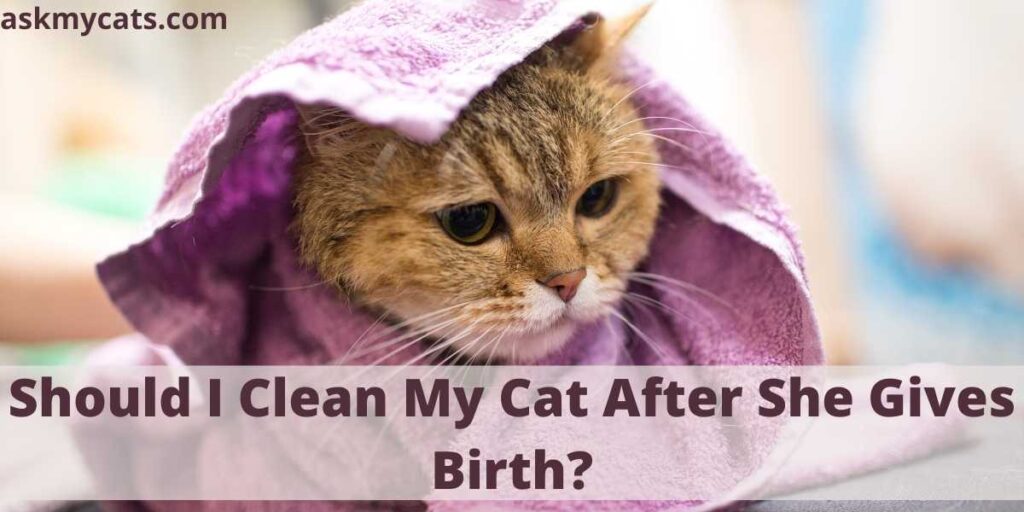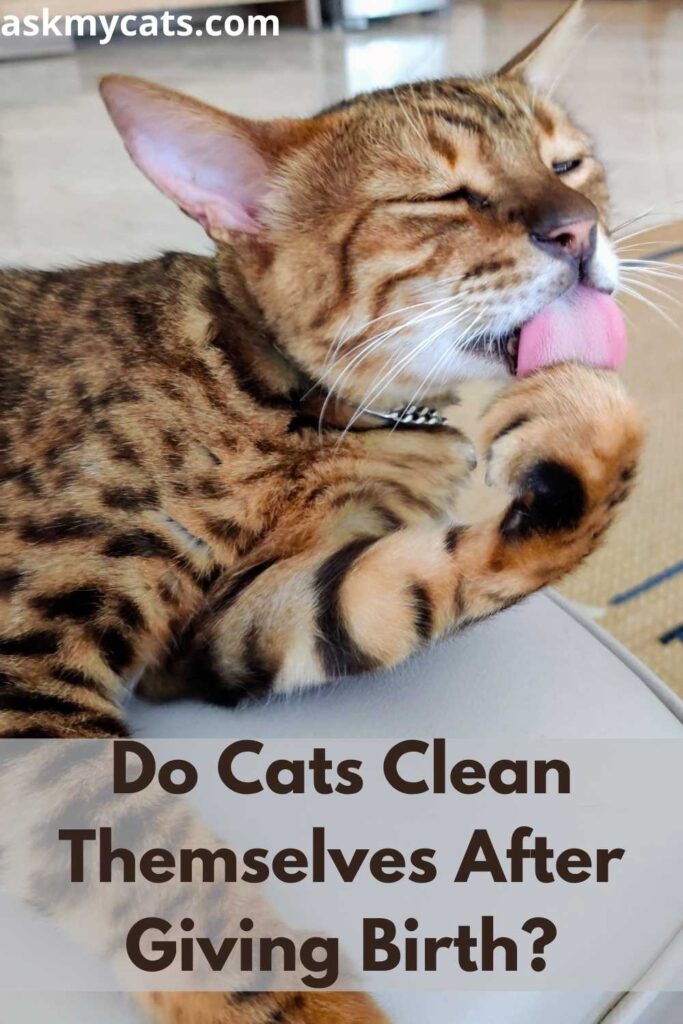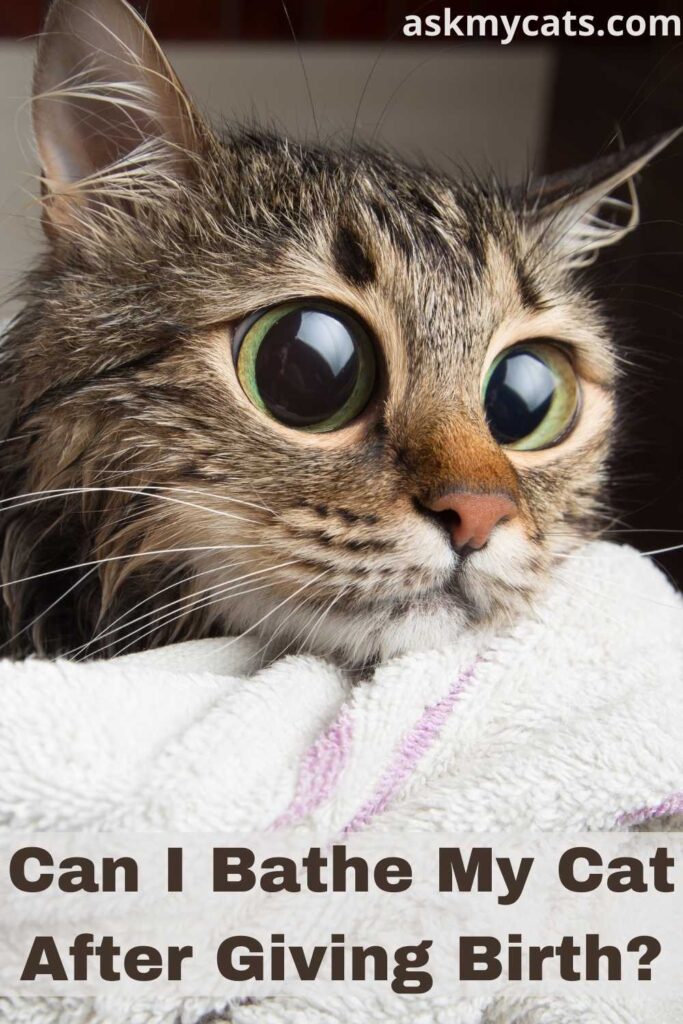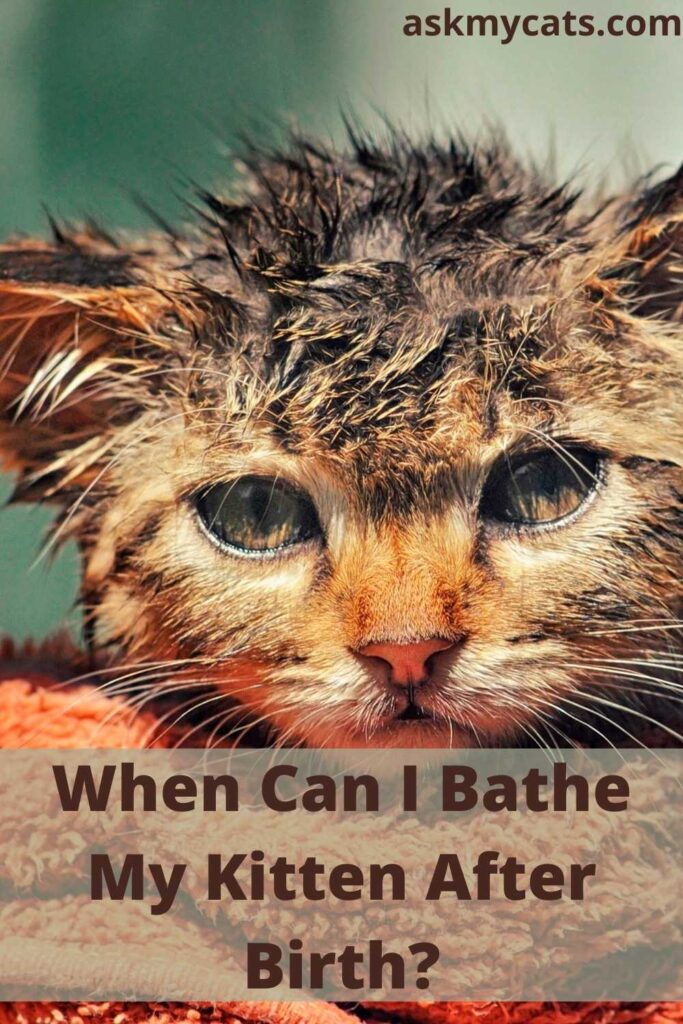It’s critical to keep a close eye on your cat and her kittens after she gives birth to ensure they’re all happy and healthy. Your cat will naturally supply all her kittens want, so keep your distance if you can to let her to settle into motherhood.
However, when should you clean your cat after she gives birth?
You should wait 2-3 days after your cat has given birth before giving her a bath. Her cervix will be closed at this stage. To ensure the safety of her babies, thoroughly rinse her to remove all of the cat shampoos. To give her a thorough cleaning, gently wipe around her vaginal area with a warm damp towel.
This article will tell you all the things you need to know before giving your cat a bath after she has given birth.


Give Your Cat the Perfect Day
Get the Free Ebook!
Do Cats Clean Themselves After Giving Birth?
Yes, cats clean themselves after giving birth.

When you consider the number of feral cats in the wild, it’s tempting to believe that cats don’t require human help when they’re going to give birth or have already given birth.
While it’s true that mother nature normally takes over and cats get along great on their own, if you have a pet cat who has given birth, keep an eye on the mother cat’s behavior toward her kittens as well as her overall health to ensure that everything is in order.
Some cats don’t seem to lick at all, whereas others lick constantly.
Cat lovers frequently inquire as to why cats lick and attempt to establish when licking is normal and when it is odd.
Cat licking is a natural component of a cat’s maternal instinct and grooming habits, although it can become excessive and aberrant.
A healthy cat will lick to keep himself or herself generally clean. The majority of cats are meticulous groomers who spend a large amount of time grooming.
The number of times cats spend grooming varies greatly from cat to cat, but studies show that cats spend about 15% of their time grooming.
Grooming after the birth. The queen combs herself after giving birth to remove natural discharge and blood. This is a natural instinct to reduce scents that can attract predators.
Grooming of the mother. The queen licks the kittens right after they are born to remove the amniotic sacs from around their faces and bodies, which stimulates respiration.
She’ll also consume the placentas and gnaw through the umbilical cords. This is entirely typical behavior.
The queen will lick her kittens frequently after birth and for the first several weeks of their lives.
The babies are encouraged to expel waste by licking their abdomens and anuses (urinate and defecate).
Around the age of three weeks, kittens learn to groom themselves. Kittens are usually capable of grooming themselves by the age of six weeks.
Can I Bathe My Cat After Giving Birth?
Yes, you can bathe your cat after giving birth but after waiting 2-3 days.

After she delivers the kittens, you can give her a bath in 2-3 days.
We don’t want any infections to get up into the uterus, therefore I wouldn’t do it sooner.
The cervix should be closed after 2-3 days, and it’s safe to bathe.
As long as you thoroughly rinse her off, the kittens will not be affected.
It’s no secret that felines keep their body clean by licking fur and genitals on their own.
The cat, on the other hand, may lack the power and ability to care for itself after childbirth or surgery (cesarean section) since its attention is diverted by the offspring.
In this instance, the concerned owner must know when to begin bathing the pet and how to do so safely so as not to hurt the frail body.
Since the mother endures tremendous physical and psychoemotional stress during labor, she should not leave the kittens alone for more than seven days.
Basically, she goes to the bathroom, eats, and drinks water like she normally does. It’s best to keep the tray and bowl in the same room as the “nest” so that the mother can keep an eye on the babies.
During this period, all hygiene procedures are reduced to replacing the litter in the box, but there can be no talk about bathing for a number of reasons.
- Most cats are terrified of water and find it difficult to perform operations that require it. And stress can be detrimental for a nursing cat since it causes it to produce less milk or stop lactating entirely, as well as change its smell and flavor.
- Particles of home items may be found on the animal’s nipples (shampoo, soap, etc.). Newborn kittens suck off these chemicals when eating, which can cause severe poisoning, vomiting, diarrhea, and even death in the weakest members of the litter.
- Inflammatory processes in the urogenital system and the female mammary glands can be triggered by incorrectly chosen water temperature (too cold or hot).
Cats, unlike dogs, do not need to be bathed after giving birth. The sebaceous glands’ natural secretion is disrupted by hard water from the tap and cosmetics.
The skin of the pet begins to dry and peel, seborrhea occurs, and the wool fades and falls out. As a result, such a rigorous sanitary process should only be performed once every 2-3 months.
When Can I Bathe My Kitten After Birth?
You can bathe your kitten after he becomes 4 weeks old.

Adult cats spend up to 50% of their waking time grooming themselves, and kittens learn to lick themselves when they are two to four weeks old.
So, why should you give your cat a wash in the first place?
Bathing stimulates the skin while also removing excess oil, dander, and hair.
It’s also a good method to teach your kitten that being handled in unusual ways isn’t going to injure them.
The vet will need to touch the cats, and vet techs will need to handle them, or house sitters and guests will need to look after them.
Making the bath a pleasurable experience aids kittens in “generalizing” the event to other comparable situations in the future.
Positive bathing experiences will come in handy if you ever need to give your kitten medicinal baths as part of a treatment plan for skin ailments like ringworm or if your kitten gets into anything really filthy.
Shorthaired kittens may rarely if ever, require a bath, but kittens with more hair may require a little more assistance with hygiene.
Bathing too frequently might dry up the skin, so limit yourself to once every 4-6 weeks or so.
Bathes are most readily accepted by kittens, so begin when it is at least 4 weeks old.
For routine cleaning, you only need a few supplies, including:
- A simple grooming shampoo labeled specifically for cats
- Several towels
- A rubber mat
- A washcloth
- Ping pong ball or other floating distraction
Use a double sink in the kitchen, two or more large roasting pans, or a couple of buckets or wastebaskets in the bathtub for small cats or kittens.
Fill each with warm water, then carefully lower your cat into the first container (one hand supporting its bottom, the other beneath the chest) to get it wet. The majority of cats prefer this procedure than being sprayed.
Allow your kitten to stand on its hind legs and grip the container’s edge as you thoroughly wet the fur.
Then lift the cat onto one of your towels and apply the shampoo, wiping the kitten’s face with a damp but not soapy washcloth.
Dip the kitten back into the first container to rinse after lathering. Remove as much soap as possible before sluicing off surplus water and rinsing thoroughly in consecutive containers of clean water.
How Do I Clean My Cat After Giving Birth?
To clean your cat after giving birth you need to minimize the stress factor for the cat, so the procedure should be performed confidently without chaotic movements, as well as promptly. Prepare yourself beforehand:
- Feed the cat in advance (at least 4 hours before bathing).
- Make sure the animal has emptied the bladder and intestines.
- Wait until the female feeds the kittens, that is, the milk leaves the mammary glands almost completely.
- Heat the air in the bathroom to a comfortable temperature of 23-25 ° C.
- Put on the shelf all the necessary accessories (shampoo, 2 types of combs, soap, cotton pads, etc.).
- Type in a bathwater up to 35 ° C, not more.
- Place a cloth or a rubber mat on the bottom of the tub or basin, which will prevent your pet from sliding.
Place the cat in the bath that has been prepared (the water level should not be higher than the chest).
Make sure one hand is on the shoulder blade when holding the cat. Soak the wool and distribute the bathing aid using your second hand in a small bucket.
Wash the foam with a scoop after foam shampooing all areas of the wool. You can use a shower, but the pressure should be extremely low so as not to frighten the animal and to prevent fluids from entering the face and auricles. Before bathing, seal the latter with a cotton pad.
Remove the cat from the water after the treatment, wrap it in a terry towel, and gently dry it. The hair should then be dried as soon as possible with a hairdryer set to an average head and temperature. This should be done in a draft-free environment.
Of course, the hygiene of a mother who has given birth to a cat is critical, as pathogenic microorganisms can thrive in sewage and matted wool.
Make sure the animal is relaxed and happy during the surgery, and start bathing the female no sooner than two weeks after giving birth.
Frequently Asked Questions
When can I touch my cat’s newborn kittens?
If at all possible, keep your distance from your cat’s newborn kittens at first. She’ll be protective of them and may not want you to touch them, so unless something is wrong, it’s best to respect her space. When you handle newborns too much, their mothers may reject them. If your cat is happy for you to do so after a few weeks, you may be able to gently massage the new kittens. From week two on, it’s critical to begin socializing the kittens, which will include some handling. You may need to act and touch your kittens sooner if your cat is struggling, ill, or has rejected any of her kittens.
How to keep a birthing cat warm and comfortable?
Assemble a comfy nesting box for the infants to rest in after the delivery. The box’s walls should be high enough to deter kittens from climbing out, but low enough for a tired cat to readily exit. Also, choose a box that is large enough for the mother to rest away from the kittens but not so large that the kittens can’t reach her. The use of newspaper at the bottom of the box will aid with odor control. Warm water bottles or a low-heat heating pad on top of that will keep the kittens warm even when they are separated from their mother. Finally, add plenty of soft towels, blankets and mattress pads to the box. Use ones without holes since tiny kitten paws and heads can get entangled in them.
What are some health issues in newborn kittens?
Kittens are the most susceptible to intestinal parasites. Infectious disorders, including as respiratory infections, and congenital diseases are other health issues that young kittens face. When a kitten fails to thrive, it is known as fading kitten syndrome. It could be a symptom of the syndrome if you notice one of the kittens is generally more lethargic and sleeps a lot more than its siblings. A veterinarian who specialized in kitten care should see that kitten right away.
Final Words
Some cats after giving birth will adore the bath, while others will despise it. During the bath, be patient and don’t chastise your cat.
If your cat is having a hard time with the bath, give him plenty of praise, ask for help, or rinse off the soap and try again later.
If bathing your cat at home appears to be too difficult, a professional groomer who is familiar with cats is your best chance for thorough cleaning.
If you have any questions, ask us in the comments section.
